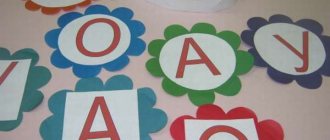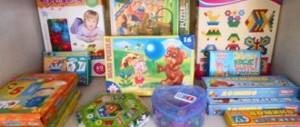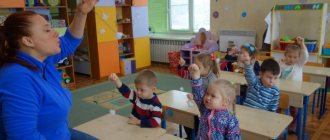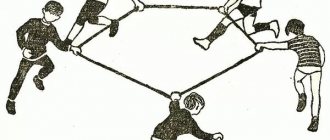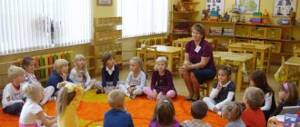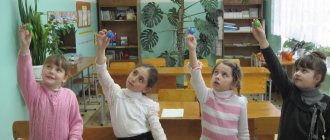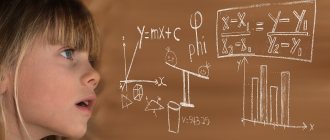Speech interaction with children of senior preschool age is one of the most productive ways to organize various types of educational activities. In the preparatory group (children 6–7 years old), conversation takes first place in the group of verbal techniques. It allows not only to solve program educational tasks, but also accustoms children to dialogue with adults and friends, that is, to the main form of interaction at the next stage of education at school.
- 2 Types of conversations in the preparatory group, card files
2.1 Table: examples of educational and ethical conversations in the preparatory group - 2.2 Files of conversations of different types in the preparatory group
- 3.1 Table: fragment of long-term planning of conversations in the preparatory group (for September, December)
- 4.1 Table: Kondrashova O.N., summary of the conversation in the preparatory group on the topic “Why you need to study”
4.1.1 Video: conversation on the topic of patriotic education in the preparatory group
Why are conversations held in the preparatory group?
In the senior and preparatory groups, the range of topics for conversation expands significantly. At the same time, the content of the conversation, determined by the program material (familiarization with the necessary set of skills in different professions, history, concepts of rights and responsibilities, etc.) and the types of children’s activities (games, work activity), is expanded by discussing the children’s personal experience in one or another question. Which, in turn, determines the target guidelines of this verbal technique:
- teaches you to draw conclusions on a particular topic, drawing on your own practical and emotional experience (for example, when talking about positive and negative characters in fairy tales, children can find good traits in “bad” characters, relying on their feelings, for example, sympathizing with the wolf from “ Three Little Pigs,” who just wanted to eat, so he behaved this way, and perhaps it was unpleasant for him);
- activating the monologue and dialogic speech of the children (the teacher’s word should make up no more than ¼ of the entire conversation);
- cultivate respect for someone else’s point of view (since the questions in the conversation are mostly problematic in nature, children’s opinions, especially regarding the assessment of actions, may differ).
During the conversation, the children learn to logically construct monologue statements and engage in the discussion in a timely manner.
Solving the following tasks helps to realize these goals of the conversation:
- building a conversation around issues of a problematic or exploratory nature;
- increasing the level of quality of speech by increasing the proportion of monologues and dialogues, and the child’s statement complies with compositional laws, that is, it has a beginning, a demonstrative disclosure of the topic of the question, and a conclusion;
- developing the ability to defend and prove one’s point of view, drawing on personal experience.
Progress of the lesson:
A “car” drives into
, in which there are bags of rose hips, vegetables and fruits and Doctor Aibolit.
D/i “Wonderful bag”
D/i “Guess the taste”
Show rose hips, explain what they are. Pay attention to the onion and offer to plant it.
MAY
TOPIC: “How will I take care of my health ”
P.s.: Strengthen your understanding of a healthy lifestyle . Continue to introduce children to the professions of a doctor and a nurse, and cultivate respect for people in these professions. Repeat proverbs about health .
Types of conversations in the preparatory group, card files
Conversations with children aged 6–7 years are varied not only in topic, but also in type. In other words, in the preparatory group the teacher organizes conversations of all types, practiced in kindergarten. And, as last year, special attention is paid to educational and ethical conversations.
In the preparatory group, conversations on educational and ethical topics predominate
Table: examples of cognitive and ethical conversations in the preparatory group
Author - Vasylishin N.A., teacher of kindergarten, school-gymnasium No. 60, Lugansk.
| Subject | Target | Progress of the conversation |
| Educational conversations | ||
| “Where can I play?” |
| The teacher reads out the rhyme:
Children play the game "Scooter". To the rhythm of the rhyme, bend one leg at the knee, imitate the push-off movement with the other leg, sliding it along the floor:
After which the children answer the questions:
|
| "I am human" |
| Children name the parts of the human body, naming the functions of each. They compare them with animals and plants, and come to the conclusion that the difference lies in the awareness of human actions, that is, only man is a rational being. The teacher suggests finding out how people differ in a broad sense (gender). The guys are divided into two teams: girls and boys, count the number of children in one and the other, determine that within the groups they differ in eye color, hair, height, weight. Using pictures of individual body parts, children create a model of their appearance. Then they talk about themselves. The teacher offers to put together their names from the letters of the cut alphabet. Summing up: man is a part of nature, all people are different and differ in a number of external and internal characteristics. |
| "Bread" |
| The teacher asks the children a riddle:
The teacher asks what kind of bread there is. Children answer that it is white, black, soft, stale, etc. An adult talks about the technology of bread production. Children, selecting illustrations in an appropriate order, summarize the stages of this process. The game “Who is more”: the teacher throws a ball to the children, they name any baked product. Physical education minute:
Children make up one sentence each with the name of any baked product. Bottom line: bread is the boss of everything. |
| "Vegetables" |
| The teacher invites the children to feel the object in the “magic bag” and say what it is. After which the teacher asks the kids to name all the models in one word: vegetables. Children answer the questions:
The teacher asks the children to lay out the vegetables on two mats: one is black, on it we need to put those vegetables from which we eat the roots, and the second is green, on it we need to place those crops from which we eat the tops. The teacher asks to name animals that are good for vegetables. Children look at the pictures and comment on the illustrations:
Summary of the conversation: vegetables are very useful, but to grow them you need to put in a lot of work. |
| Ethical Conversations | ||
| “What do we know about mom?” |
| The teacher reads out the rhyme:
Then the teacher asks the kids to tell about their mother: what the child feels for his mother, what words he says to her. The teacher turns to the children for an explanation of the concept of “golden hands” and asks them to tell how kids help their mothers around the house. Then the teacher organizes a ball game “How I Help Mom”: he throws the ball to the children one by one, they catch it and say how they are helping. Bottom line: the family rests on the mother, the children should help her. |
| "My family" |
| The teacher introduces the children to the topic with the help of a poem:
After that, the children play the “Family” lotto: everyone receives cards with a picture of mom, dad, grandmother, etc. Then, one by one, they take a small card out of the box with an illustration of an activity and place it next to their relatives in order. For example, “Grandfather and I are making dumplings.” If this was not the case, the small card must be returned to the box. The one who closes all the cards wins. Children define the concept of family, remember proverbs and sayings on the topic. The teacher tells the fairy tale “The Family of Wizards”: “In one ordinary family of wizards, something incredible happened: the boy Vasya stopped obeying his mother, who asked him to clean his running boots. Then mom announced that she would not listen to dad: he would come home from work and ask to lay out a self-assembled tablecloth, and mom would say that she had taken it to the dry cleaner. Dad heard this and announced that he, too, was now no longer listening to grandfather: he would tell dad to clean the flying carpet of dust, and dad would refuse him. And grandfather also did not remain in debt: he says, they say, that’s it, I will no longer obey my grandmother: water her magic apple tree or feed her goldfish. The grandmother looked at Vasya and declared that she would no longer obey him and would not tie the invisibility cap. Vasya thought and thought and decided that he had to obey his mother, then the others would help each other. So they will have a magical family.” The teacher asks the children if they have magical families. Bottom line: family is love, care and respect. |
| "Friendship" |
| The teacher offers to play the “Club of Friendship”: children, sitting in a circle, unwind a ball of thread, passing it on and saying nice words to a friend. The teacher asks whether it was easy to say good words, then moves on to the essence of the conversation and invites the children to answer the following questions:
Children remember proverbs about friendship, and then select pictures that match the content of the stories “Three Comrades” by V. Oseeva, “Childhood Friend”, “Friends Known in Trouble” by V. Dragunsky. The teacher offers to play the game “Living Pictures”: one mini-group receives a picture and uses gestures and facial expressions to describe what is happening on it. The second mini-group tries to describe their pantomime in words. The conversation ends with the game “Caterpillar”: children with balls stand in a column one at a time, holding the ball between their stomach and the back of the comrade in front. Thus, to the song “If you went on a journey with a friend,” the children move around the room. A teacher with children sums it up: friends need to be protected. |
| "How to deal with a book" |
| The teacher shows a torn book that Dunno ruined. The adult asks the children to evaluate Dunno’s actions and explain to the boy why books need to be handled carefully. Then the teacher offers to read a story from a torn book and stops at the most interesting place: there is no page - Dunno tore it out. Children formulate rules for handling books for Dunno:
Dunno realizes that he behaved incorrectly and invites the children to paste in a page to finish reading the story. The teacher finishes reading and sums it up together with the children: books must be taken care of. |
This is interesting. The content of cognitive and ethical conversations in the preparatory group is closely intertwined, since the age of the children allows us to consider a particular problem from different angles, touching on both one and the other area.
The topics of educational and ethical conversations in the preparatory group are closely intertwined
Card files of different types of conversations in the preparatory group
As in the older group, compiling a file of conversations with children 6–7 years old is based on the principle of grouping by topic or educational area. Card files on the topic are convenient because it is easier for the teacher to choose a conversation that is suitable for a particular lesson. For example, you can see a sample of a thematic card index on the topic “Family” in the work of teacher O.S. Zarubina.
Organizing a file cabinet by educational area is a more convenient option due to the increase in the number of topics studied. Thus, an example of a block of conversations on promoting a healthy lifestyle can be found in the work of teacher M.I. Tozikova.
It is very important when working with children 6–7 years old to repeat and enrich cultural and hygienic skills. Therefore, it is impossible to do without conversations in this area. An option for compiling a card index can be seen in the publication of teacher Lomovskaya L.V.
A calendar-thematic plan for situational conversations in the preparatory group on various topics is presented in the work of L. Lisenkova here
Conversations of a precedent nature can also be conducted by invited specialists. For example, talking with a law enforcement official about traffic rules or with a doctor about the importance of vaccinations.
In the preparatory group, morning conversations remain no less relevant, giving an idea of the topic of the day, as well as allowing one to select a problem for situational discussion, that is, an issue that arose during the children’s stay in the group. You can get an idea of this block of conversations in the publication of teacher D.S. Nishchetova.
This is interesting. Due to the peculiarities of the format of individual conversations, namely, organization as needed, their topics are taken from blocks on specific educational areas: for example, from a card index on KGN, if a child forgets to wash his hands or eats sloppily.
Compiling conversation files makes it easier to select a suitable conversation for the topic of a segment of the educational process
Card index of conversations with children of the preparatory group according to the Federal State Educational Standard
These conversations in the preparatory group (a card index with goals for the Federal State Educational Standard is the basis) will help in conducting interesting and productive classes with preschoolers. The Federal State Educational Standard helps to comply with uniform requirements for the preparation of children. There are a lot of topics for conversations that will be interesting for children:
- space;
- traffic regulations;
- profession of firefighter and his work;
- garden;
- my home street;
- hour, minute and second;
- ecology and others.
Conversation at the preschool educational institution
Conversations in March in the preparatory group
The title of the conversation is “The Happy Month of March.”
Goal: Systematize knowledge about spring and International Women’s Day.
Progress:
- “Guys, please tell me what three spring months you know! Right! March, April and May."
- “Who can tell what happens to nature in March?”
- “If December is the beginning of a fierce winter, then March is the beginning of a wonderful spring.”
- “The guest spring arrives, the snow begins to melt, the rooks arrive, the sun shines warmer and brighter, and winter recedes. Nature is slowly waking up from hibernation.”
- “And our main spring holiday is March 8 or International Women’s Day. The first person we congratulate on this holiday will always be mother.”
Fire theme
Conversation about spring in the preparatory group
The goal is to systematize and clarify children’s knowledge about spring. To teach to see the dependence of living nature on inanimate nature. Learn to generalize signs.
The tasks are to clarify and systematize knowledge about the signs of spring, to list the spring months.
For your information! It is important to teach children to talk about the content of the poem after listening. Convey the emotions received from listening to the poem.
It is worth teaching how to receive aesthetic pleasure from spring nature.
Interesting! Preliminary work - a walk around the territory of the kindergarten in the spring. Reading a poem about spring. Drawing on the theme “Spring has come.” Listening to a song about spring. View illustrations and paintings about spring. Individual puzzle about spring.
Demo material:
- Reproduction of a painting by S.A. Vinogradov "Spring".
- Children's song (recording) “Spring Drops”.
- Presentation with pictures for the poem.
Handout - illustrations about spring.
Equipment:
- easel;
- MP3 player;
- laptop and projector.
Methodical techniques:
- conversation-dialogue;
- a game;
- listening to a song;
- looking at illustrations.
Spring theme
Progress of the conversation:
- “Guys, listen to Agracheva’s children’s poem “Spring.”
- “Which poem is this - sad or funny? Why?"
- “How does boron change in spring? The snow melts in it, it becomes lighter, and thawed patches form.”
- “What animals are the poem talking about? About the bear, hares, rooks, hedgehogs, squirrels, songbirds.”
- “How are they feeling with the arrival of spring? The bear wakes up, the bunnies, rook, hedgehog, and squirrel are happy and active. The birds begin to sing.
- “How do you feel with the arrival of spring?”
- “Name the birds and animals that winter in Russia: elk, hare, wolf, fox, bear, raven, crow, sparrow, arctic fox, squirrel, sable, hedgehog, tit, jackdaw, pigeon, wood grouse, wild boar, vole, owl, eagle owl, waxwing, partridge.”
- “List the spring months (March, April, May). March is the first month of spring. It comes when February ends. Rooks and sparrows arrive, make noise, and tits clink. The bear wakes up. But it may still be warm in March.”
- “Who remembers what holiday is celebrated in March? That's right - March 8th. It's International Women's Day."
- “April is the second or middle month of spring. Streams are flowing because the sun is shining brighter and the snow is melting. Thawed patches appear. The buds of the awakening trees are swelling. Coltsfoot is blooming. Bunnies exchange their winter down for summer.”
- “In May (the last month of spring) it is already getting warmer. The snow has melted, the first rains and even thunderstorms with thunder and lightning are coming. Apple, lilac, cherry and other trees are blooming.”
- “And in May, what national holiday is celebrated in our country - Victory Day. Victory over Nazi Germany."
- Physical education session to the song “Spring Drops”.
- Viewing a reproduction of a painting by S.A. Vinogradov "Spring". “What signs of spring can be seen in this picture? More sun, snow melts and thawed patches appear, leaves bloom on the trees.”
Experimental activities in the middle group
Conversation with children of the middle group “Maslenitsa”
The title of the conversation is “Daring Maslenitsa.”
The goal is to introduce children to Russian folk holidays.
Progress:
- “Children, have you heard of such a holiday? Do you know when it is celebrated? Every year Maslenitsa is celebrated at different times and the date of its celebration depends on Easter. This holiday symbolizes the end of winter and the arrival of the long-awaited spring.”
- “Let's list together everything that is connected with Maslenitsa: folk festivities, burning of effigy, pancakes, fun, fun. Maslenitsa festivities continue for a whole week. People bake pancakes and treat them to friends and family.”
- “For our ancestors, pancakes symbolized the sun and warmth. At the end of Maslenitsa week, the Maslenitsa effigy, which was previously made from straw, is burned. The scarecrow symbolizes winter, which is already over. People, burning the effigy of Maslenitsa, say goodbye to winter, drive it away so that it goes away quickly and the long-awaited warmth comes. Did you take part in such a celebration?”
- Listen to a poem about Maslenitsa.
- “Does this poem convey sadness or joy? What attributes of Maslenitsa are mentioned in it - about pancakes, stuffed animals, sun and joy.”
Note! When burning stuffed animals, you need to be safe.
Conversation about school in the preparatory group
The title of the conversation is “Hello, school!”
The goal is to form an idea of the school.
School theme
Progress:
- “Guys, before we start talking with you, let’s listen to the song “What They Teach at School.”
- “What emotions does this song evoke in you? Let’s list what they teach at school: letters, that is, the alphabet, numbers, multiplying, subtracting, reading, writing, not offending little ones, being well-mannered, cherishing friends.”
- “At what age do people usually start going to school? From the age of 7. Sometimes they can admit you to school a little earlier or a little later. Do you already want to go to school? Why?"
- “At school there are lessons and breaks. Children study during lessons, and during breaks they relax, play, and go to the dining room. School teaches responsibility and discipline. You will need to learn not to be late, complete assignments on time, and do your homework at home. Your first teacher will help you with this.”
- “Who knows when the school year starts - in September. What date? That's right - the first of September. This is the Day of Knowledge."
- “Let's play a game. Each of you will turn gray and name one word that he associates with school. The one who cannot remember the word is eliminated. The last person remaining will be the winner. Words: school, desk, board, chalk, form, ruler, eraser, teacher, physical education, recess, dining room, classmate, drawing, call, friends, vacation, knowledge, homework, task, example, letter, number, class, mathematics, reading, assignment, holiday, meeting, five, two, diary, notebook, textbook, computer, Internet, brush, pen, pencil, compass, felt-tip pen.”
- The task is to draw yourself on the first day of school.
Conversation about health in the preparatory group
The title of the conversation is “If you want to be healthy.”
The goal is to systematize knowledge about a healthy lifestyle.
Progress:
- “Guys, I think you all know that the most important thing is health. Remember what is most often wished for a person on his birthday - of course, health! And it’s not just like that.”
- “Remember the time when you were sick. There is nothing good in this state.”
- “It is much more pleasant to feel healthy and therefore cheerful, cheerful and energetic. It’s not for nothing that they say: “You can’t buy health,” “A healthy mind in a healthy body.”
- “Let’s list together what helps a person to be healthy.”
- “Proper nutrition. What do you understand by these words - eat more fruits and vegetables, eat porridge for breakfast, combine meat with vegetables, eat a varied diet, eat less sweets.”
- “Drink clean drinking water. Drink on an empty stomach in the morning and 20-30 minutes before each meal.”
- Sports activities. Exercise in the morning.
- "Fresh air. What you need to do for this is to ventilate the apartment every day, be sure to take a walk every day.”
- “Have you heard the saying: “Cleanliness is the key to health.” What it is? This means not only keeping your body and clothes clean, but also your home. Regularly do wet cleaning and get rid of unnecessary trash.”
- “Assignment - draw your favorite way to be healthy.”
How to teach a child to count - effective and proven methods
Important to remember! A conversation on life safety in the senior group is definitely necessary.
Conversation about family in the preparatory group
The title of the conversation is “The Seven Selves.”
The goal is to form an idea of the importance of family.
Progress:
- “How can you explain the meaning of the word “family”? These are people who are usually relatives to each other and are ready to help each other.”
- “How many people can there be in a family? A lot of? How about two? Even two people are already a family! This could be a husband and wife who do not yet have children, or a parent and child.”
- "You have a big family? Do you all live together? Let’s each take turns telling a little about his family and why he loves them.”
- “Now think about why a person needs a family.”
- The task is to draw your family.
Family theme
Conversation about healthy lifestyle in the preparatory group
The title of the conversation is “What is a healthy lifestyle?”
The goal is to introduce healthy lifestyle skills and promote a healthy lifestyle among preschool students.
Progress:
- “Children, who knows what these letters Z, O and Z mean? This is an abbreviation, i.e. abbreviation, and it means a healthy lifestyle. This means that you need to live in such a way as to preserve and maintain your health.”
- “Let’s now list together a few rules for a healthy lifestyle.”
- “Do not have bad habits (do not smoke, do not drink alcohol, do not use drugs).”
- “Play sports and walk a lot in the fresh air.”
- “Eat a balanced diet. This means eating a little of everything. Try not to eat fast food, don’t drink sugary carbonated drinks, eat less sweets.”
- “Keep a daily routine. What it is? This means doing everything at approximately the same time every day.”
- “Be sure to get enough sleep and ventilate your room. Make it a habit to get up early.”
- “Can you say to yourself that you lead a healthy lifestyle?”
Interesting! It is useful to introduce a morning ritual, for example, turning on upbeat music.
How to make a long-term plan for conversations in a preparatory group
With children 6–7 years old, conversations of various types are held every day. Therefore, to include different types of conversations in the work, the teacher draws up a long-term plan, in which he indicates questions for each conversation within the framework of the direction of development of the child’s personality.
Table: fragment of long-term planning of conversations in the preparatory group (for September, December)
Author - Pushkareva I.A., teacher of the MADOU Combined Kindergarten "Rainbow", Yugorsk, Khanty-Mansiysk Autonomous Okrug.
| Direction | 1 Week | 2 week | 3 week | 4 week | ||||
| September | ||||||||
| The child enters the world of social relations | Topic: “How I spent my summer”
| Topic: “Where does the bread on the table come from?”
| Topic: “Who makes toys?”
| Topic: “I live in Russia”
| ||||
| Child in the natural world | Topic: “Such different insects”
| Topic: "Birds"
| Topic: “The beauty of autumn nature”
| Topic: "Mushrooms"
| ||||
| The child enters the objective world | Topic: “Soon to school”
| Topic: “I visit the library”
| Subject. “Man has always worked”
| Topic: “Rural professions”
| ||||
| Valueological education of the child | Topic: “I am a man”
| Topic: “What is health?”
| Topic: “We must, we must wash ourselves in the mornings and evenings”
| Topic: “Why do we need doctors”
| ||||
| A child in the world of other people | Topic: “What is a kindergarten?”
| Topic: “How should you say hello?”
| Topic: “Who came up with the rules of behavior and why?”
| Topic: “Adult labor in autumn”
| ||||
| December | ||||||||
| The child enters the world of social relations | Topic: “How to call a doctor at home”
| Topic: “Why and how to harden yourself”
| Topic: “I am proud of my parents’ work”
| Topic: “Our good deeds in nature”
| ||||
| Child in the natural world | Topic: “Sun and Planets”
| Topic: “Fauna of the North”
| Topic: “Winter natural phenomena (snow, frost, ice)”
| Topic: “Birds in winter”
| ||||
| The child enters the objective world | Topic: “Where did the bread come from”
| Topic: “Who bakes bread?”
| Topic: "Household Appliances"
| Topic: “New Year holidays”
| ||||
| Valueological education of the child | Topic: “Sun, air and water are our best friends”
| Topic: “How to care for your skin?”
| Topic: “A healthy mind in a healthy body”
| Topic: “On the rules of behavior in public transport”
| ||||
| A child in the world of other people | Topic: “Families big and small”
| Topic: “Dangerous situations when contacting strangers”
| Topic: “How should one behave when visiting?”
| Topic: “New Year - a family holiday”
| ||||
How to write a summary of a conversation in a preparatory group
The structure of the conversation is universal, regardless of the type, direction or age of the children. In this case, the duration of the conversation in the preparatory group increases to 25 minutes. This time is distributed between three stages of solving the issue:
- introduction to the problem - up to 2 minutes (the reduction in time at this stage compared to the previous year is explained by the fact that children 6–7 years old are able to concentrate faster);
- the main stage of the conversation - up to 20 minutes, that is, developing the topic in the conversation through explanation, reading poems, riddles, using visual aids, as well as conducting physical education;
- final - up to 3 minutes (in the preparatory group, the teacher only directs the children’s train of thought, but does not pronounce conclusions for the children, as was practiced in the middle group and partly in the senior group).
Conversations in the preparatory group, as well as in junior, middle and senior groups, can be conducted on behalf of a toy character
Table: Kondrashova O.N., summary of the conversation in the preparatory group on the topic “Why you need to study”
| Stage | Content |
| Introductory | The appearance of the fairy-tale hero Dunno. (Sadly greets the kids) The teacher asks why he is so sad. -Here it is September 1st. We have to go to school. But I don't want to go there! I do not want to study! - Dunno, you definitely need to study. -Guys, tell our guest why you need to study? (Children's answers) The teacher turns to Dunno with the question of what he will do when he becomes an adult. - I will be a doctor. The boys and I often play hospital. I already know everything. I will cure everyone! The teacher asks the children: “Guys, will you go to be treated by such a doctor?” (Children's answers) - Dunno, you need to study to become a doctor. First at school, then at other educational institutions (For example, a university). -I see... I thought I knew everything. “Soon the boys will become students too.” And the knowledge gained at school will be useful in your life. Now you will see a story about piglets who also did not want to go to school. |
| Basic | Once upon a time there were piglets, very friendly guys, they never worked out, they played all day long. They were too lazy to study, they just ran around all day. But one day their mother sent them to the store, She said: “There is no milk, and there is not enough bread, Well, with the rest of the money, kids, buy yourself some candy.” And in the store the seller is the Gray Wolf's sister, the Red and cunning Fox. She took their money, sold them the goods, and did not give them change. And the children said sadly: “Milk and bread. Where are the sweets? The fox smiled slightly, and quietly licked her lips. “They probably didn’t take enough money, or maybe they lost it.” The poor piglets are crying, that's how it happens, guys. |
| -Why were the piglets so upset? - Guys, why did such a disaster happen to them? Come up with a continuation of this story (children's options). | |
| Conclusion: To avoid getting into such situations, guys, learn to read and count. You must go to school and listen to the teacher very carefully. | |
| Final | Dunno says: “I will definitely go to school. And I will be the most attentive." -Guys, continue the sentence: “You need to study in order to...” |
Morning conversation with children in the older group
Morning activities are part of the daily routine in kindergarten. In addition, conversations in the morning with the children in the middle group are part of the daily routine of each pupil.
Morning conversation at the preschool educational institution
Before starting mental work and work, as well as rest, it is important to talk with children on a pre-selected topic. This regime is considered to be well-structured, and therefore has serious pedagogical significance.
Dramatizations of Teremok and other fairy tales in the second junior groups
Daily morning activities:
- They teach children to a certain regime.
- They help provide the body with a change in activity, that is, they protect the central nervous system from overstrain.
- They help to form strong dynamic stereotypes of life.
In a word, conversation in the morning is an important moment in the life of every student. In the future, growing up, he will, as usual, unwind, relaxing in the morning while talking in the family, with relatives.
Experts recommend combining conversations with active games. It is necessary to attract the attention of children by any means. Any description of a thematic conversation in kindergarten suggests that children will be 100% interested in such activities if they are accompanied by fun games. This maintains positivity and makes you want to participate in everything that happens. For example, you can create the appearance of a conversation on the phone. The teacher can also interest the children by offering the children the game “Ko knows more polite words.”
Attention! The integrated use of different types of activities is an excellent means of enhancing educational work with preschool children.
The teacher must remember that a good morning is a good day. The shift begins with a friendly meeting of the children. As soon as they enter the kindergarten, they are immediately encouraged to talk about a fascinating or educational topic. This is a great way. The child simply comes to kindergarten and unobtrusively gets involved in a wide variety of activities. But only an experienced teacher will be able to accurately determine the state, thoughts and worries of each student, which will actually make it possible to create a cheerful mood in the child and a desire to socialize and play with classmates.
For example, a child may come in sad in the morning, he is irritated and silent. Noticing that the student is worried, the teacher should carefully and calmly address him when talking, try to “talk” and calm him down.
On a note! The politeness of the teacher will make it clear that the child is safe and can trust the adult. Or perhaps the child is worried about what happened in the family, the mother, father, they are planning something for a vacation, a holiday. The teacher should listen carefully to this message, involving the students in the conversation. This is a great topic for a new conversation.
One way or another, the kind words of an adult, gentle questions, smiling, humor, the ability to listen and understand, give some advice, discuss, approve, praise and reassure - all this makes it possible to improve the child’s activities, as well as create an atmosphere of mutual understanding, trust and kindness , friendship. This is exactly how communication in kindergarten should be.
